Jul 4, 2022 | celebration
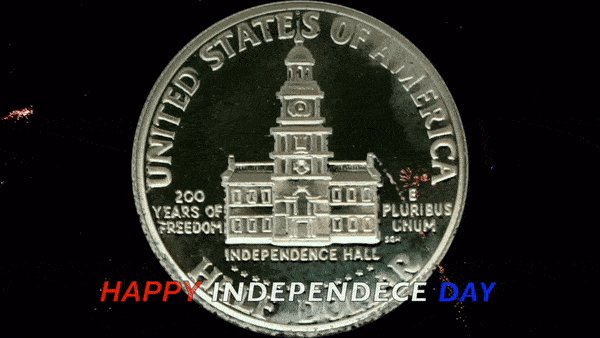 The decision to go to war to confirm independence was not something the English colonies in the New World took likely. After many years of trying to convince King George III, and over the objection of Benjamin Franklin, Thomas Jefferson began to author what was effectively a declaration of war.
The decision to go to war to confirm independence was not something the English colonies in the New World took likely. After many years of trying to convince King George III, and over the objection of Benjamin Franklin, Thomas Jefferson began to author what was effectively a declaration of war.
To convince Franklin and other skeptics to support the fight for independence, Jefferson presented the preamble of what would become the beginning of the Declaration of Independence to the Continental Congress. It passed on May 15, 1776.
As a result, the Continental Congress appointed a “Committee of Five” to draft a declaration. Committee members were John Adams of Massachusetts, Benjamin Franklin of Pennsylvania, Thomas Jefferson of Virginia, Robert R. Livingston of New York, and Roger Sherman of Connecticut. They completed the draft on June 28, 1776.
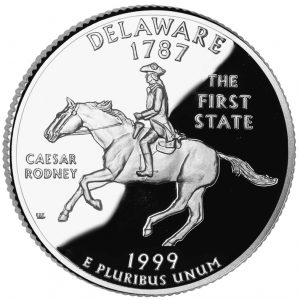 The Continental Congress debated the draft on July 1-2, 1776. New York and South Carolina were still holdouts, and the two Deleware representatives were deadlocked. This led to the historical ride of Caesar Rodney, who rode 80 miles to Philadelphia to vote in favor of independence.
The Continental Congress debated the draft on July 1-2, 1776. New York and South Carolina were still holdouts, and the two Deleware representatives were deadlocked. This led to the historical ride of Caesar Rodney, who rode 80 miles to Philadelphia to vote in favor of independence.
After Thomas Jefferson made the final agreed upon corrections to the document, the Continental Congress approved the draft on July 4, 1776, with 12 votes. Only New York abstained since they did not have the authority of their government.
The final signatures were added on August 2, 1776. Since New York approved the resolution of independence on July 10, the New York delegation is included among the signatures.
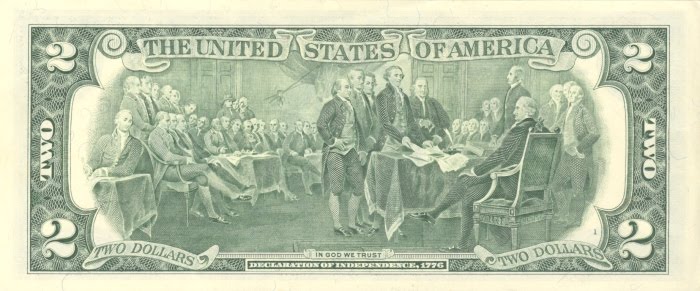
Reverse of the Series 1976 $2 Federal Reserve Note features an engraved modified reproduction of the painting The Declaration of Independence by John Trumbull.
Although we celebrated the nation’s birth in 1776, the new country was not recognized until 1783, when the two nations signed the Treaty of Paris.
Nov 25, 2021 | celebration
-
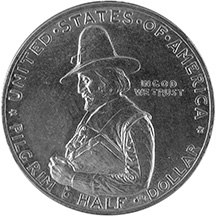
-
This coin commemorates the 300th anniversary of the landing of the Mayflower. The image is of a pilgrim carrying a Bible.
-
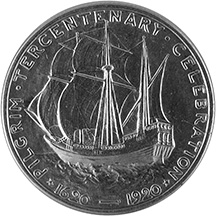
-
The image is of the Mayflower, the ship that brought the pilgrims to Massachusetts.
Thanksgiving in the United States is traced back to the Pilgrims’ celebration of their first successful harvest in 1621. The three-day event was attended by 53 Pilgrims and 90 Native Americans that lasted three days. The tradition of giving thanks for successes was a tradition that the Pilgrims brought with them from England. This three-day celebration in 1621 is considered the first Thanksgiving.
Although there is no record of the menu, the meal likely consisted of food from the harvest, venison, and seafood. Legend has it that the local natives killed five deer as gifts for the celebration.
On the 400th anniversary of that event, Native Americans have been working on setting the record straight. One difference from the original story is that the local natives were not invited. The story goes that the warriors showed up when they heard gunshots coming from the European camps thinking that a war was to begin. It was not a war, but the colonists were shooting muskets to celebrate.
Uncovering historical information is similar to using ancient coins to gain a better understanding of history. If we better understand our past, we can improve the future. Let’s improve the future by being thankful and welcoming to all who call this country home.
Happy Thanksgiving
Jul 6, 2021 | celebration, personal
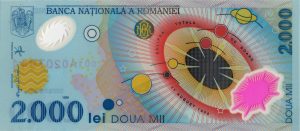
1999-Series Romanian 2000 Lei Banknote
On April 14, 2013, I posted my 1,000th article.
Today, July 6, 2021, I am posting my 2,000th article!
When I started this blog, there were few websites for coin collectors. Numismatic publications were barely online. Their web presence was used to lure subscribers to their print editions. Since starting this blog, there has been a growth in numismatic news outlets and other information. I welcome everyone who has joined me online.
It has been 6,003 days since my first post. That translates into 16 years, 5 months, and 8 days. Over that time, many of those producing numismatic information has come and gone. However, after 2,000 posts, I am still here as the sole author of everything posted here.
I did not know what would happen as I kept writing, but I never thought about reaching 2,000 or lasting more than 16 years!
To those who have been around from the beginning, thank you for staying with me.
To those who joined since the beginning, thank you for reading.
If you like what you read, share, and show your support 
Jul 4, 2021 | celebration

Reverse of the Series 1976 $2 Federal Reserve Note features an engraved modified reproduction of the painting The Declaration of Independence by John Trumbull.
Apr 18, 2021 | celebration, coins, dollar
WELCOME TO NATIONAL COIN WEEK!
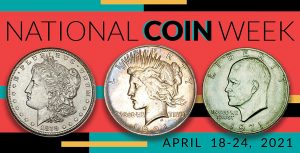 Starting today, April 18, 2021, through April 24, National Coin Week celebrates “Money, Big and Bold,” the history of the large dollar coin. The influence for this year’s NCW theme is the 100th anniversary of the revival of the Morgan Dollar and the first issue of the Peace Dollar. It is also the 50th anniversary of the first Eisenhower Dollar, the last of the large dollar coins.
Starting today, April 18, 2021, through April 24, National Coin Week celebrates “Money, Big and Bold,” the history of the large dollar coin. The influence for this year’s NCW theme is the 100th anniversary of the revival of the Morgan Dollar and the first issue of the Peace Dollar. It is also the 50th anniversary of the first Eisenhower Dollar, the last of the large dollar coins.
The dollar coin has had a fascinating history in the United States. Before paper money and during the wild days referred to as Broken or Obsolete Banknotes, before the National Bank Act of 1863, coins were considered safer than the barely regulated paper. As with many policies of the time, paper money was more in favor in the eastern United States than in the west. The west preferred the coins.
In 1918, Congress passed the Pittman Act, whose purpose was to supply the British with silver to help with their war effort. When the British repaid the United States, the government had to produce silver coins to replace coins melted to create the bullion shipped to Britain.
In 1921, the U.S. Mint had not produced a silver dollar since 1904 and did not have dies to produce coins. Chief Engraver and the coin’s designer Charles Morgan created new master dies to produce coins.
When the U.S. Mint discussed creating the new dies, former ANA President Farman Zerbe presented a paper at the 1920 World’s Fair of Money proposing the Peace Dollar. Congress eventually agreed, which led to the committee that picked Anthony di Franchisci’s design. Production of the Peace Dollar began in 1921.
The Peace Dollar almost made an appearance in 1964 when Congress proposed striking a new dollar coin. But the silver shortage and the end of using silver for circulating coinage ended this program. Allegedly, the U.S. Mint destroyed all 1964 Peace Dollar patterns.
In 1969, Mint Directory Mary Brooks wanted to issue dollar coins. As part of the negotiations with Congress to authorize a new coin, she suggested honoring the former World War II General and President Dwight D. Eisenhower. The suggestion convinced Congress to pass the legislation, and the U.S. Mint began Eisenhower Dollar production in 1971.
In 1975, the U.S. Mint was concerned with the level of resources required to produce the coin. Negotiations began to produce a smaller dollar coin. The results of these negotiations led to the introduction of the Susan B. Anthony Dollar in 1979, ending the production of the large circulating dollar coin.
All of the posts this week will be about large dollar coins except for Monday. Monday’s post will have a special announcement.
And now the news…

April 13, 2021
In the viral video, Webber explained that the giant safe was so big they had to hire a crane to retrieve it. He said they thought it might contain something. So they made the decision to break it open.

→ Read more at
pennlive.com

April 13, 2021
Two Jacksonville ISD students in the Gifted and Talented program are using their coin collections for their GT projects. According to GT teacher Chelsea Best, the students’ GT project is one in which students conduct independent research on a subject of their own choosing.

→ Read more at
jacksonvilleprogress.com

April 13, 2021
The images on the world's smallest commemorative coin are too small to see with the naked eye A tiny Swiss gold coin bearing a picture of Albert Einstein sticking his tongue out has been crowned as the world's smallest commemorative coin, Switzerland's mint announced Tuesday.

→ Read more at
phys.org

April 13, 2021
(Kitco News) Even though gold's spot prices are still trading below $1,750 an ounce, the real price of gold is a few hundred dollars higher, according to Ed Moy, former U.S. Mint director and currently chief market strategist at Valaurum.

→ Read more at
kitco.com

April 17, 2021
B. Max Mehl, an immigrant lad who clerked in a shoe store for 25 cents a week, made a fortune from small change. When customers paid, he examined their cash for rare pennies, nickels, dimes and half dollars.

→ Read more at
star-telegram.com

April 18, 2021
The surprise discovery of three jam jars filled with gold bars and hundreds of gold coins in an old building marked for renovation has left a mountain community in eastern France perplexed and celebrating.

→ Read more at
theguardian.com
If you like what you read, share, and show your support 
Mar 17, 2021 | celebration, coins, commemorative, silver, US Mint
 The United States Mint released the Christa McAuliffe Proof Silver Dollar in a socially distanced ceremony where they presented the first coin to First Lady Dr. Jill Biden, honoring her lifelong dedication to teaching.
The United States Mint released the Christa McAuliffe Proof Silver Dollar in a socially distanced ceremony where they presented the first coin to First Lady Dr. Jill Biden, honoring her lifelong dedication to teaching.
NASA selected Christa McAuliffe to be the first member of the Teacher in Space Program. The space agency would train teachers to travel to space and hold lessons from the space shuttle. Unfortunately, 73 seconds into the flight, the Space Shuttle Challenger disintegrated, killing all seven members aboard.
Jill Biden began her education career as a substitute teacher in 1975. She went to school part-time to earn her Master of Education, completing her coursework while pregnant with her daughter Ashley. After a few years, Biden returned to the classroom teaching English in a public high school. In January 2007, at age 55, she earned a Doctor of Education (Ed.D.) before hitting the campaign trail for the Obama-Biden ticket.
Dr. Biden is a champion for education and plans to teach again this fall.
During the issuing ceremony, Biden said:
There’s a saying Christa loved and it’s inscribed on the coin that we unveiled today: ‘I touch the future I teach.’ And this coin, like her life, is a tribute to all educators, as Steve [McAuliffe] said. It’s a reminder of the incredible power we hold to write our history and to shape our future. And it’s a recognition of the obligation we have to keep working toward a time when all students have all that they need to thrive. So thank you to all the educators who touch the future.
The coin’s sale price includes a $10 surcharge paid to the FIRST® (For Inspiration and Recognition of Science and Technology) robotics program to promote leadership in science, technology, engineering, and mathematics (STEM).
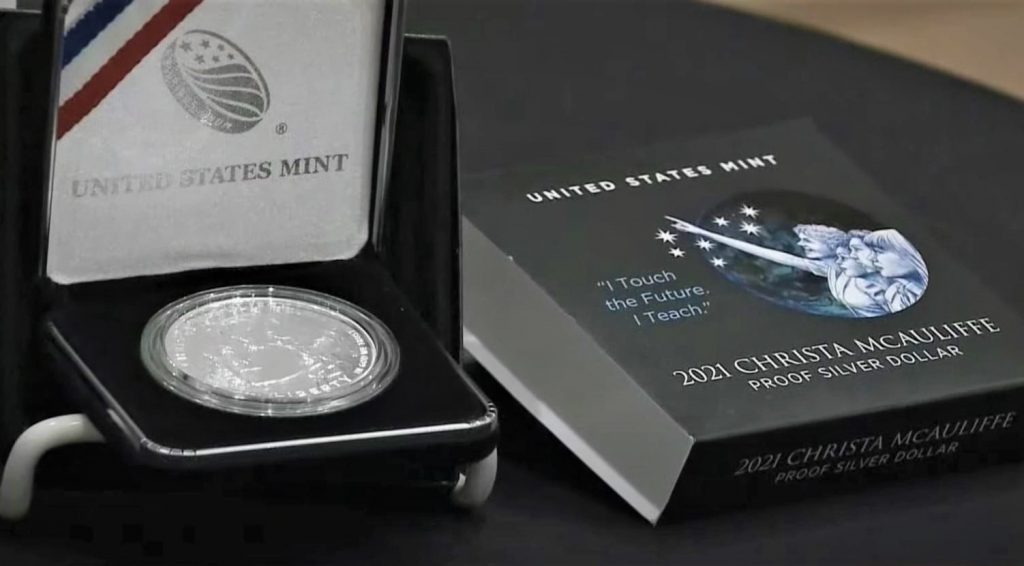
Credits: All images are courtesy of the U.S. Mint via social media.
Aug 18, 2020 | celebration, commemorative, commentary, silver
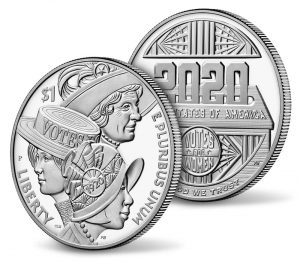 On August 18, 1920, Tennessee became the 36th state to ratify the 19th Amendment to the United States Constitution. After a battle in the Tennessee House, which was lead by an anti-suffragist leader, two members changed their votes at the last minute.
On August 18, 1920, Tennessee became the 36th state to ratify the 19th Amendment to the United States Constitution. After a battle in the Tennessee House, which was lead by an anti-suffragist leader, two members changed their votes at the last minute.
Although people in the United States tout the “right to vote,” suffrage has been a long and difficult fight since before the signing of the Constitution. It did not end with the 19th Amendment as its text did not eliminate the discrimination based on race.
The fight for the “right” continues today. Reduced access to polls, including the closing of precincts in minority districts and hindering the Postal Service’s ability to handle ballots, infringe on everyone’s suffrage rights.
The commemorative coin reflects the history of the movement by depicting women wearing different hat styles during the thick of the fight. The movement started to gain momentum in the 1870s when states and territories in the West allowed women to vote. The first attempt to pass an amendment for suffrage began in 1878, where the depiction of the commemorative coin begins.
On the reverse is a depiction of a ballot box. The box has an art deco design with the centennial anniversary year looming large as it is descending into the ballot box.
The coin was designed by Christina Hess, a member of the Artistic Infusion Program and sculpted by Phebe Hemphill. The dollar coin is .999 silver with a mintage limit of 400,000. The sale of each coin includes a $10 surcharge paid to the Smithsonian Institution’s American Women’s History Initiative.
It is an excellent design to depict the 100th Anniversary of the ratification of the 19th Amendment. Although I am not a collector of commemorative coins, this may be one that I will add to the coins I collect because the design is worthy of collecting.
May 8, 2020 | celebration, coins, legislative
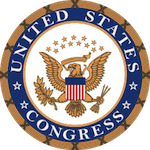 Although the calendar passed May the Fourth (be with you) and Cinco de Mayo, the days are running together that the one thing I forgot was the end of April. Days are blurring together to the point that I forgot that Thursday was senior day at some local stores. I do not mind the label of a senior citizen. It means that I survived to wear that moniker.
Although the calendar passed May the Fourth (be with you) and Cinco de Mayo, the days are running together that the one thing I forgot was the end of April. Days are blurring together to the point that I forgot that Thursday was senior day at some local stores. I do not mind the label of a senior citizen. It means that I survived to wear that moniker.
So that I can correct this senior moment, it is time to talk about the one numismatic-related bill introduced in the House of Representatives in April.
H.R. 6555: United States Semiquincentennial Quarter Series Act
Referred to the House Committee on Financial Services. — Apr 17, 2020
Introduced in House — Apr 17, 2020
The United States Semiquincentennial Quarter Series Act (H.R. 6555) would create a five quarters program to celebrate the U.S. Semiquincentennial (250 years) in 2026. If the bill passes, the U.S. Mint will “issue quarter dollars in 2026 with up to five different designs emblematic of the United States semiquincentennial. One of the quarter dollar designs must be emblematic of a woman’s or women’s contribution to the birth of the Nation or the Declaration of Independence or any other monumental moments in American History.”
According to the bill, the Secretary “may” mint “$1 coins with designs emblematic of the United States semiquincentennial.”
H.R. 6555 takes a different approach than the Bicentennial coinage. For the Bicentennial, the program lasted two years, 1975-1976. The coins were dated 1776-1976, and the reverse of the quarter, half-dollar, and dollar coins were redesigned. The previous designs returned in 1977.
The country is busy with other issues rather than being concerned with the nation’s semiquincentennial. But it is nice to think about a celebration than the worries we are going through today.
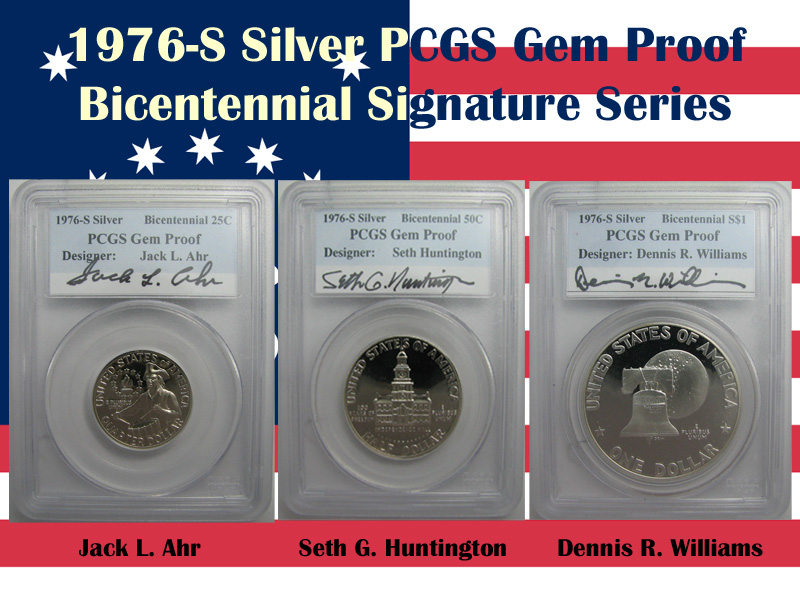
1976-S Silver Proof Bicentennial Autograph Set
Feb 9, 2020 | Carson City, celebration, commemorative, news, US Mint

Mold used to make the dies for the Carson City Mint Sesquicentennial medal. Image courtesy of the Nevada State Museum.
Although named for Henry Comstock, he did no discover the silver mines in the area. Comstock has the distinction of claiming a stake in the lode before selling his stake for thousands of dollars, an unreasonable sum at the time, and settling in Carson City. Comstock started a few businesses. His brashness and presence lent his name to the discovery.
Comstock is not a hero. He was known for being impatient, careless, lazy, and some accused him of being insane. Comstock committed suicide in 1870, leaving several failed businesses, a failed marriage, and sever debt in his wake.
After the discovery, it was expensive to transport the silver to San Francisco for processing. Nevada politicians lobbied congress for the formation of a branch mint to assay and strike coins. Congress authorized a mint in 1868 for nearby Carson City. The building opened for production in 1870. The Carson City branch mint struck silver and gold coins but in lesser amounts than the other mints making their coins highly collectible and more expensive because of their rarity.
Many consider the coins struck at Carson City to be amongst the most beautiful of all the coins. With the lower production totals, mint employees did not have to rush production, allowing them to create proper strikes. Of course, mistakes happen, and varieties of coins struck at the Carson City Mint are some of the most desirable.
A significant distinction of the coins struck in Carson City is that they bear the “CC” mintmark. It is the only two-character mintmark used on U.S. coins.
Production ended in 1893 with the reduced output from nearby silver mines. The building served as an Assay Office beginning in 1895. It closed following the gold recall of 1933. The State of Nevada purchased the building in 1939.
Today, the building houses the Nevada State Museum, where Coin Press No. 1 continues to strike commemorative half-ounce silver medals every month. There are only four known versions of this coin press in existence and the museum has the only working model.
For the sesquicentennial celebration, the museum struck a commemorative medal for the visitors. Visitors were able to purchase half-ounce silver planchets from the museum’s gift shop and bring them to the Coin Press No. 1 for striking. Because this was an on-demand process, you had to be at the museum to purchase one.
The Mint at Carson City is a symbol of U.S. history. It is where the old west meets modern commerce. From the reports, it sounds like the celebration went well. I hope to be able to visit the museum at some point in time.
And now the news…

February 3, 2020
The huge coin weighs five kilograms (Picture: The Goldsmiths’ Company/SWNS) A £5,000 coin that weighs five kilos and is big enough to eat your dinner off has been produced by the Royal Mint as part of a tradition going back more than 700 years.

→ Read more at
metro.co.uk

February 4, 2020
A giant discovery of nearly 70,000 coins from the Iron Age has set a Guinness World Record for being the largest of its kind discovered in the British Isles. Discovered in January 2012, the collection of 69,347 coins was found in Jersey by metal detector enthusiasts Reg Mead and Richard Miles, British news agency SWNS reports.

→ Read more at
foxnews.com

February 6, 2020
It was born out of Nevada's silver boom. The Carson City Mint coined our money for decades, until 1893 when it closed…later becoming the Nevada State Museum. But museum curator Robert Nylen told me it’s still famous for the coins: "The coins that came out of Carson City.

→ Read more at
ktvn.com

February 6, 2020
(via Kamloops RCMP) Kamloops RCMP has a bit of spare change these days.

→ Read more at
kamloopsmatters.com

February 8, 2020
(Kitco News) U.S. Mint gold coin sales saw a strong recovery in January after the weakest year on record in 2019.

→ Read more at
kitco.com

February 8, 2020
Persistent archaeological treasure hunters have set a new Guinness World Record for the largest coin hoard ever discovered in the British Isles. This treasure story begun in the early 1980s after Reg Mead and Richard Miles read a report about a farmer on Jersey who many years earlier had discovered silver coins in an earthenware pot while pulling out a tree from a hedgerow.

→ Read more at
ancient-origins.net

February 8, 2020
A PORTLAND resident has discovered another 'love token' at Church Ope Cove, prompting theories about what once took place on the sandy shores. Edward Dahl first found a silver sixpence, dating from 1696 during the reign of William III, back in 2018.

→ Read more at
dorsetecho.co.uk

February 9, 2020
It is the second time in history when a coin issued by Latvijas Banka has been recognised the Coin of the Year. The innovative Honey Coin, created by the designer Artūrs Analts, won by a very wide margin, and, quoting the 1 February 2020 press release of the Numismatic News, "the day was sweet as honey" for Latvijas Banka.

→ Read more at
baltictimes.com
Oct 31, 2019 | celebration
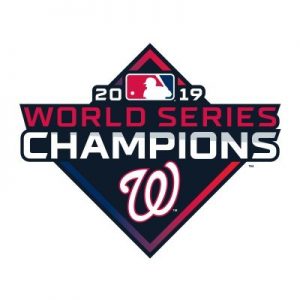 The talk around the Washington, DC metropolitan area is not what is happening on Pennsylvania Avenue. It is what will be happening on Constitution Avenue starting at 2:00 PM on November 2. According to the Mayor’s office, the parade for the World Champion Washington Nationals will begin on Constitution Avenue NW at 15th Street NW and end on Pennsylvania Avenue NW at 3rd Street.
The talk around the Washington, DC metropolitan area is not what is happening on Pennsylvania Avenue. It is what will be happening on Constitution Avenue starting at 2:00 PM on November 2. According to the Mayor’s office, the parade for the World Champion Washington Nationals will begin on Constitution Avenue NW at 15th Street NW and end on Pennsylvania Avenue NW at 3rd Street.
A rally will be held at the end of the parade route.
If you are a baseball fan, you hope that every World Series goes six or seven games. Most of the drama comes in those last two games. This series was no different.
Obligatory numismatic content:
Fans of the Nationals can purchase a commemorative plaque from the Danbury Mint that includes a bronze medal. This is an uncompensated message only used so that I had something numismatic to add!
 The decision to go to war to confirm independence was not something the English colonies in the New World took likely. After many years of trying to convince King George III, and over the objection of Benjamin Franklin, Thomas Jefferson began to author what was effectively a declaration of war.
The decision to go to war to confirm independence was not something the English colonies in the New World took likely. After many years of trying to convince King George III, and over the objection of Benjamin Franklin, Thomas Jefferson began to author what was effectively a declaration of war. The Continental Congress debated the draft on July 1-2, 1776. New York and South Carolina were still holdouts, and the two Deleware representatives were deadlocked. This led to the historical ride of Caesar Rodney, who rode 80 miles to Philadelphia to vote in favor of independence.
The Continental Congress debated the draft on July 1-2, 1776. New York and South Carolina were still holdouts, and the two Deleware representatives were deadlocked. This led to the historical ride of Caesar Rodney, who rode 80 miles to Philadelphia to vote in favor of independence.







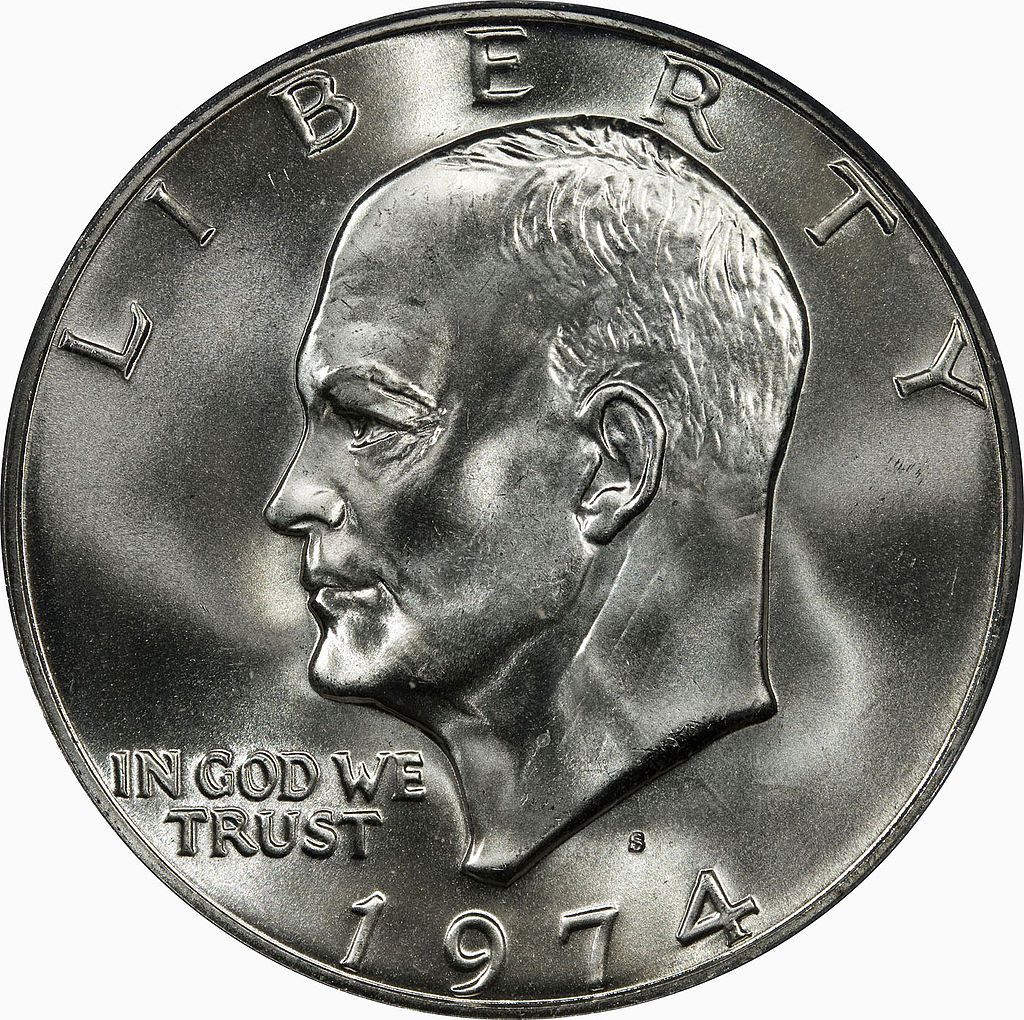
 → Read more at
→ Read more at 


 Although the calendar passed May the Fourth (be with you) and Cinco de Mayo, the days are running together that the one thing I forgot was the end of April. Days are blurring together to the point that I forgot that Thursday was senior day at some local stores. I do not mind the label of a senior citizen. It means that I survived to wear that moniker.
Although the calendar passed May the Fourth (be with you) and Cinco de Mayo, the days are running together that the one thing I forgot was the end of April. Days are blurring together to the point that I forgot that Thursday was senior day at some local stores. I do not mind the label of a senior citizen. It means that I survived to wear that moniker.

 The talk around the Washington, DC metropolitan area is not what is happening on Pennsylvania Avenue. It is what will be happening on Constitution Avenue starting at 2:00 PM on November 2.
The talk around the Washington, DC metropolitan area is not what is happening on Pennsylvania Avenue. It is what will be happening on Constitution Avenue starting at 2:00 PM on November 2. 